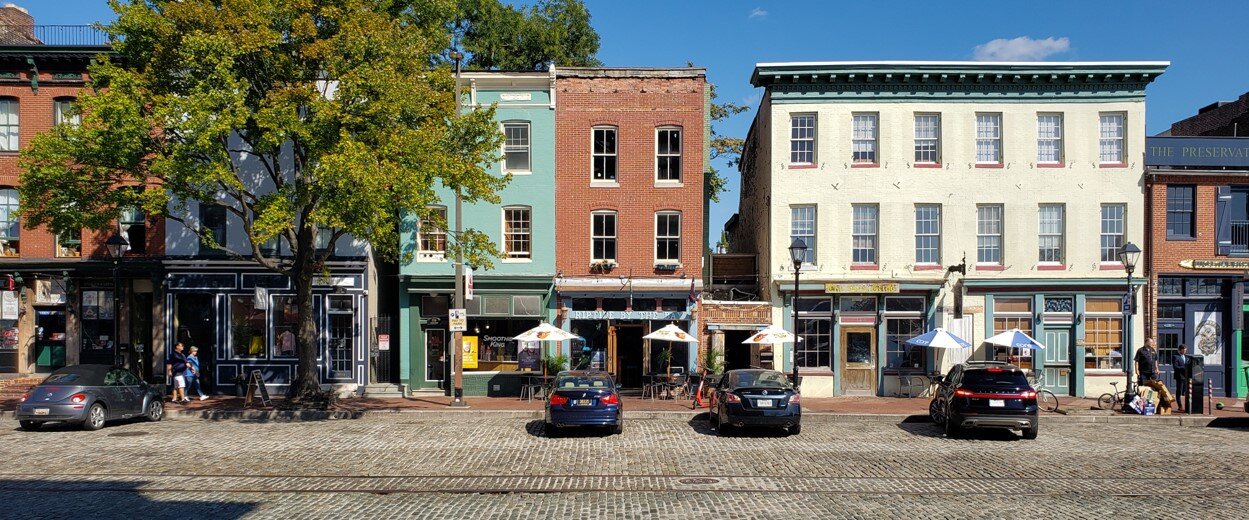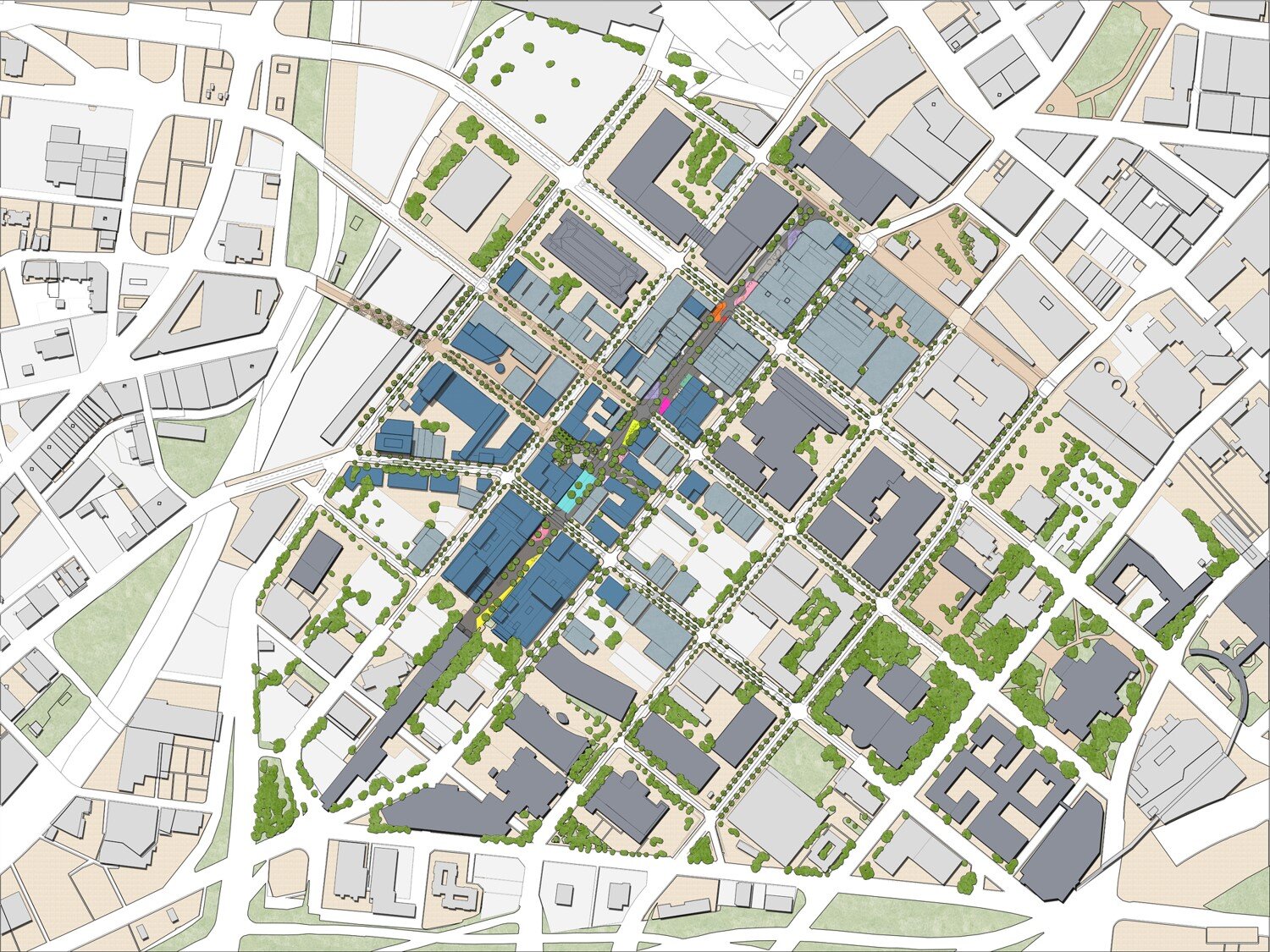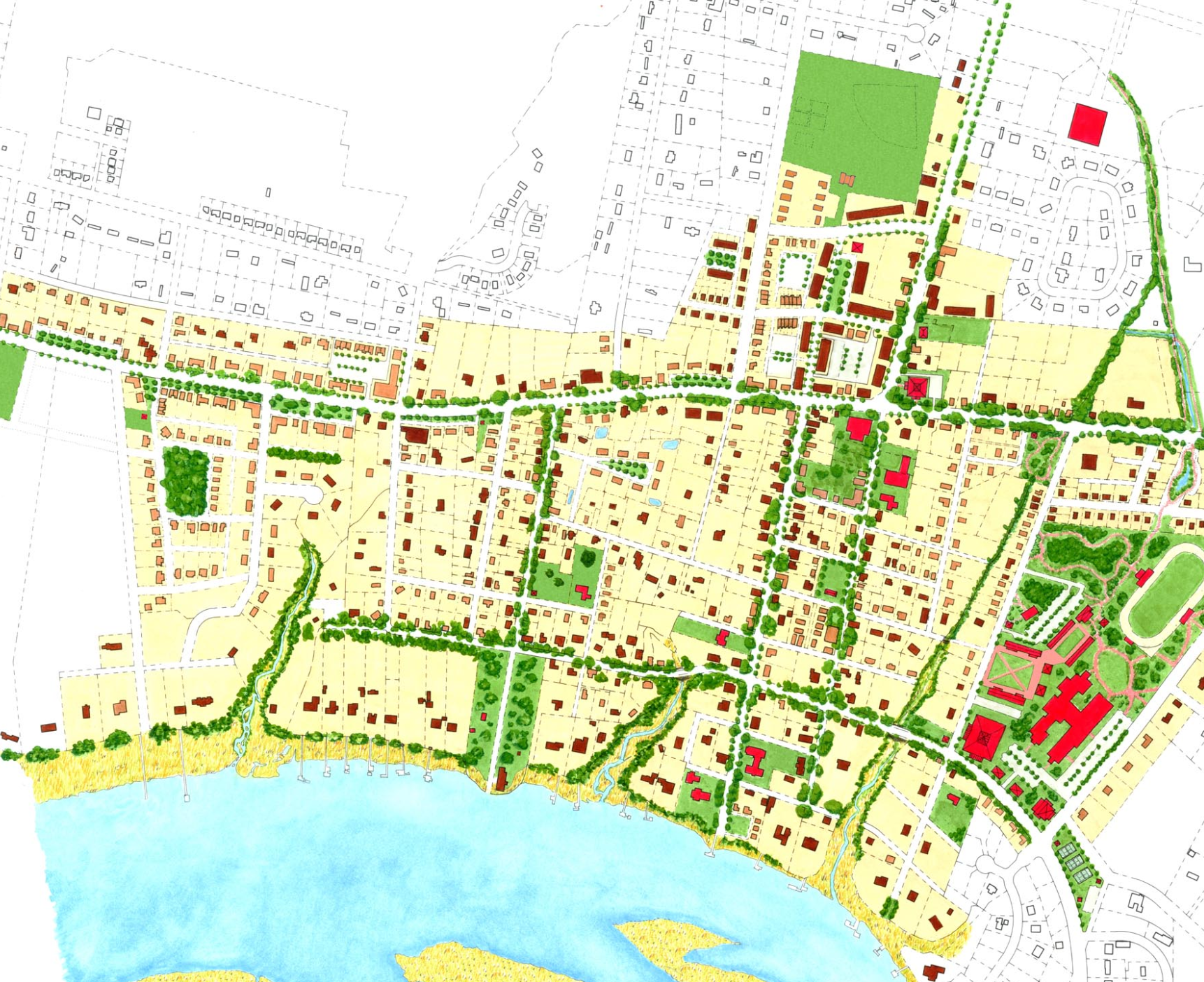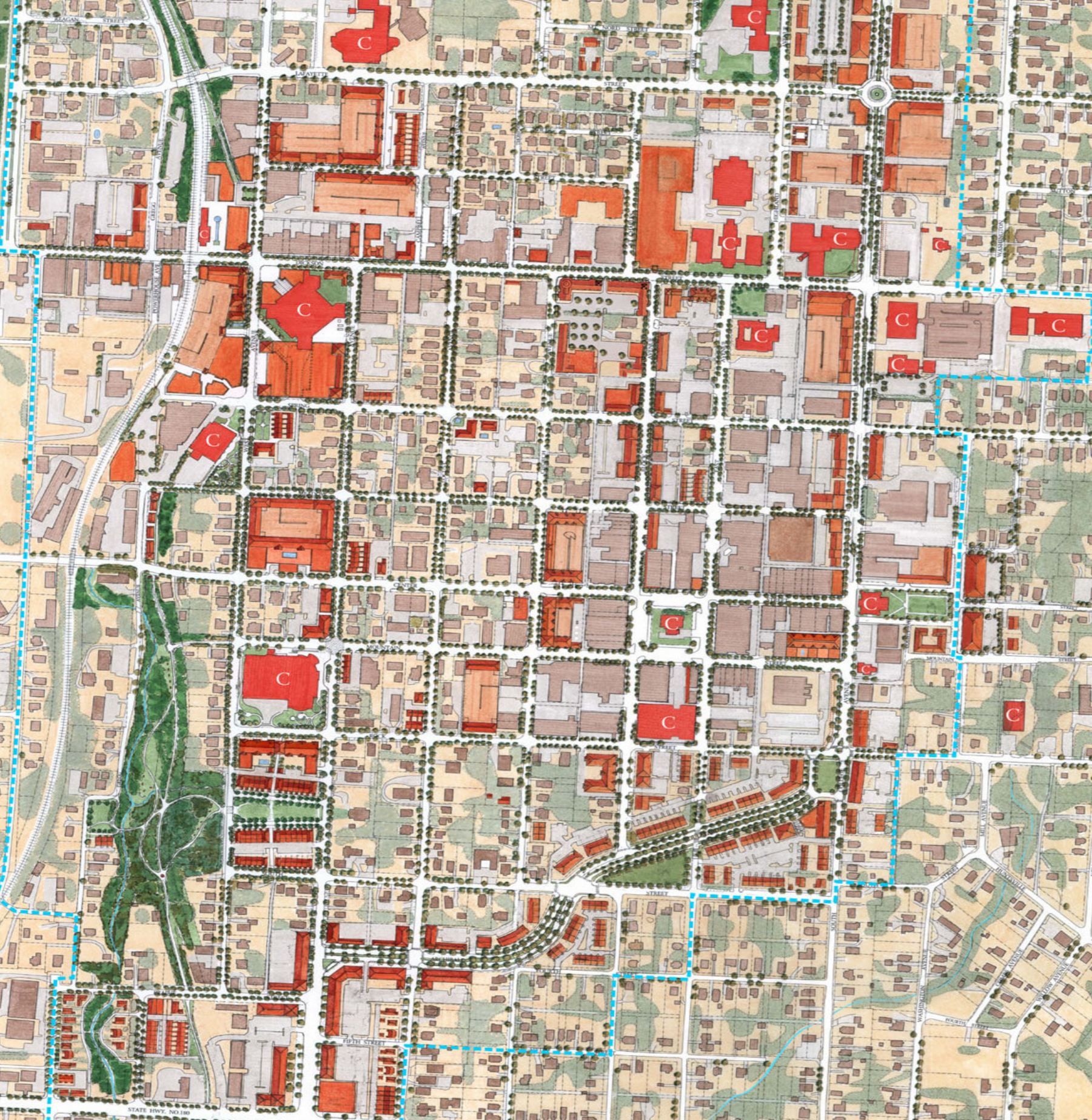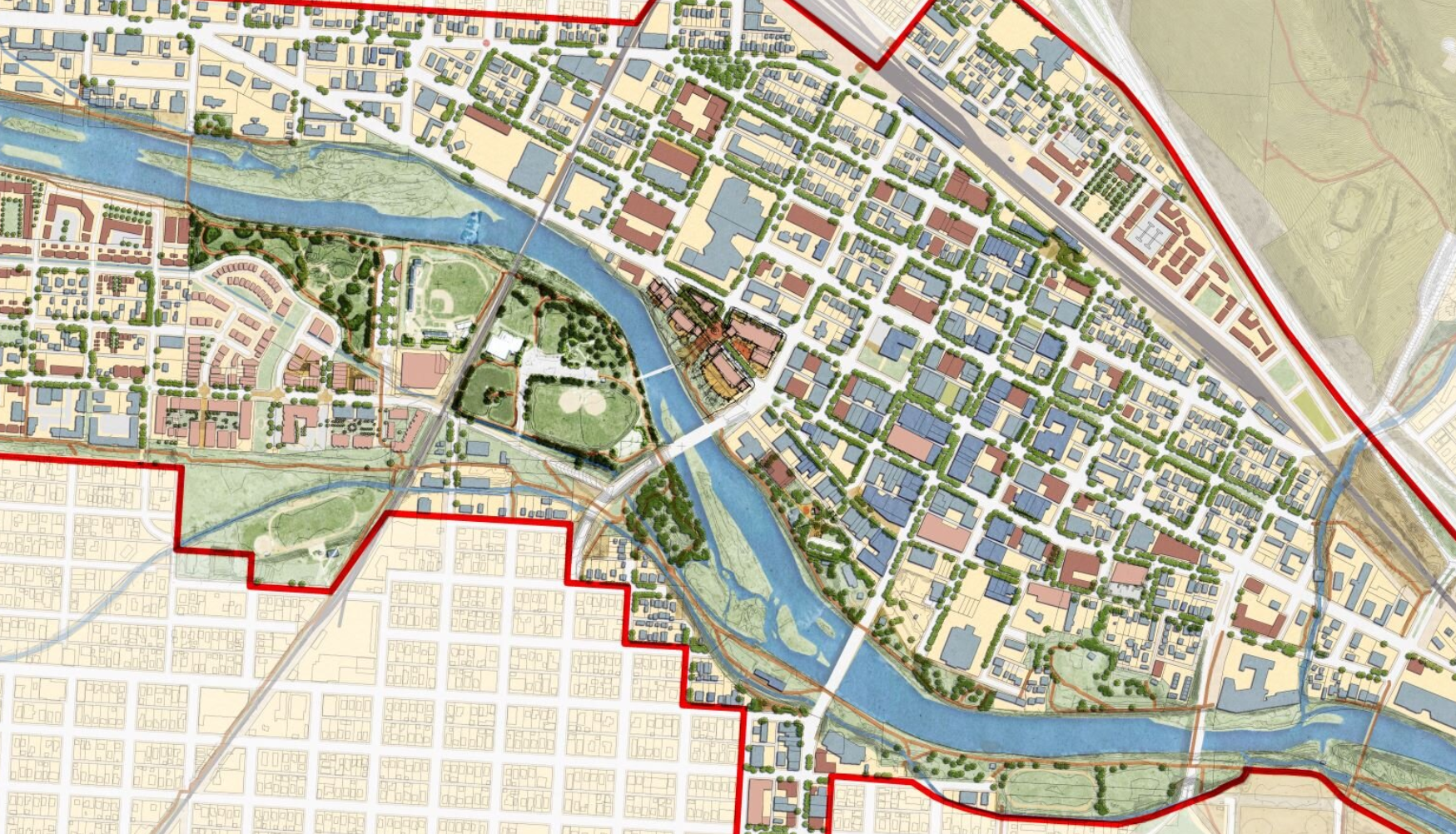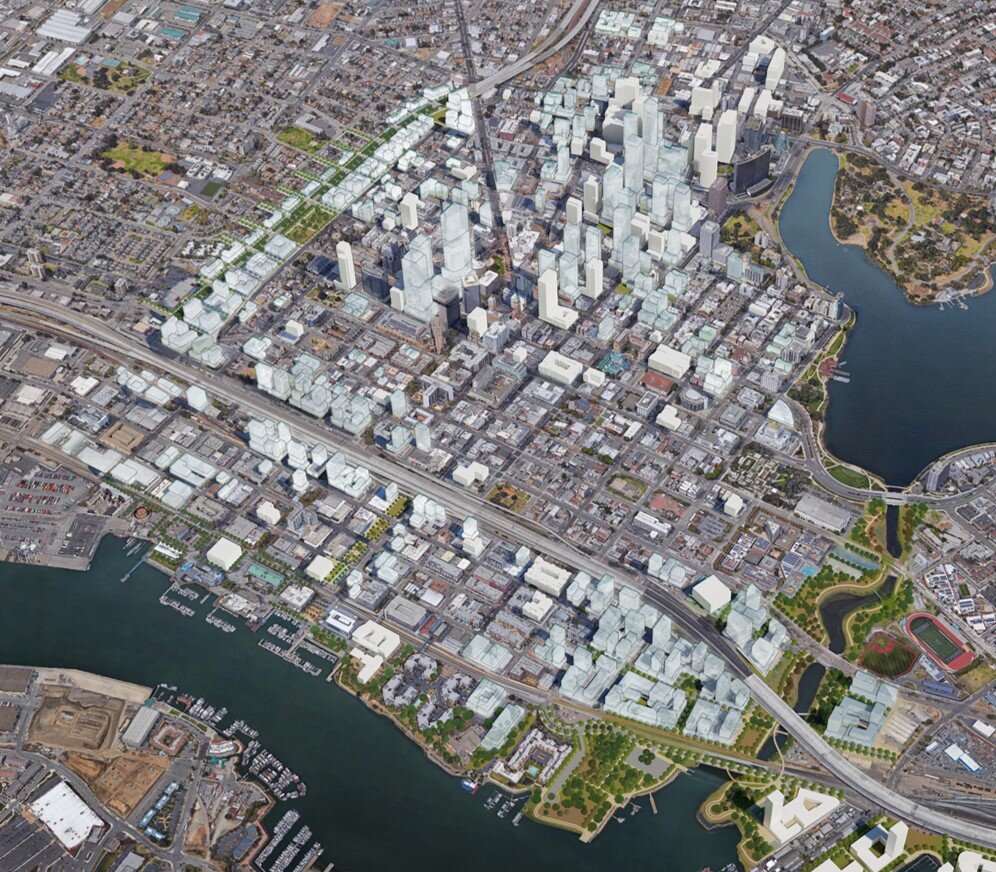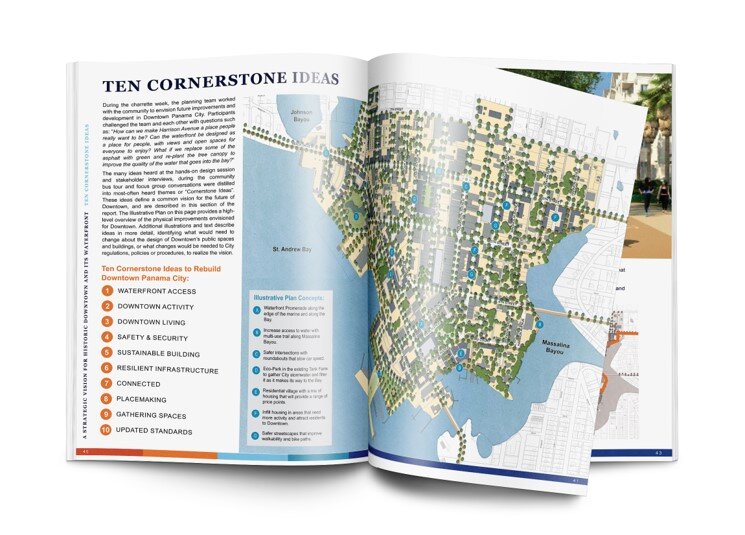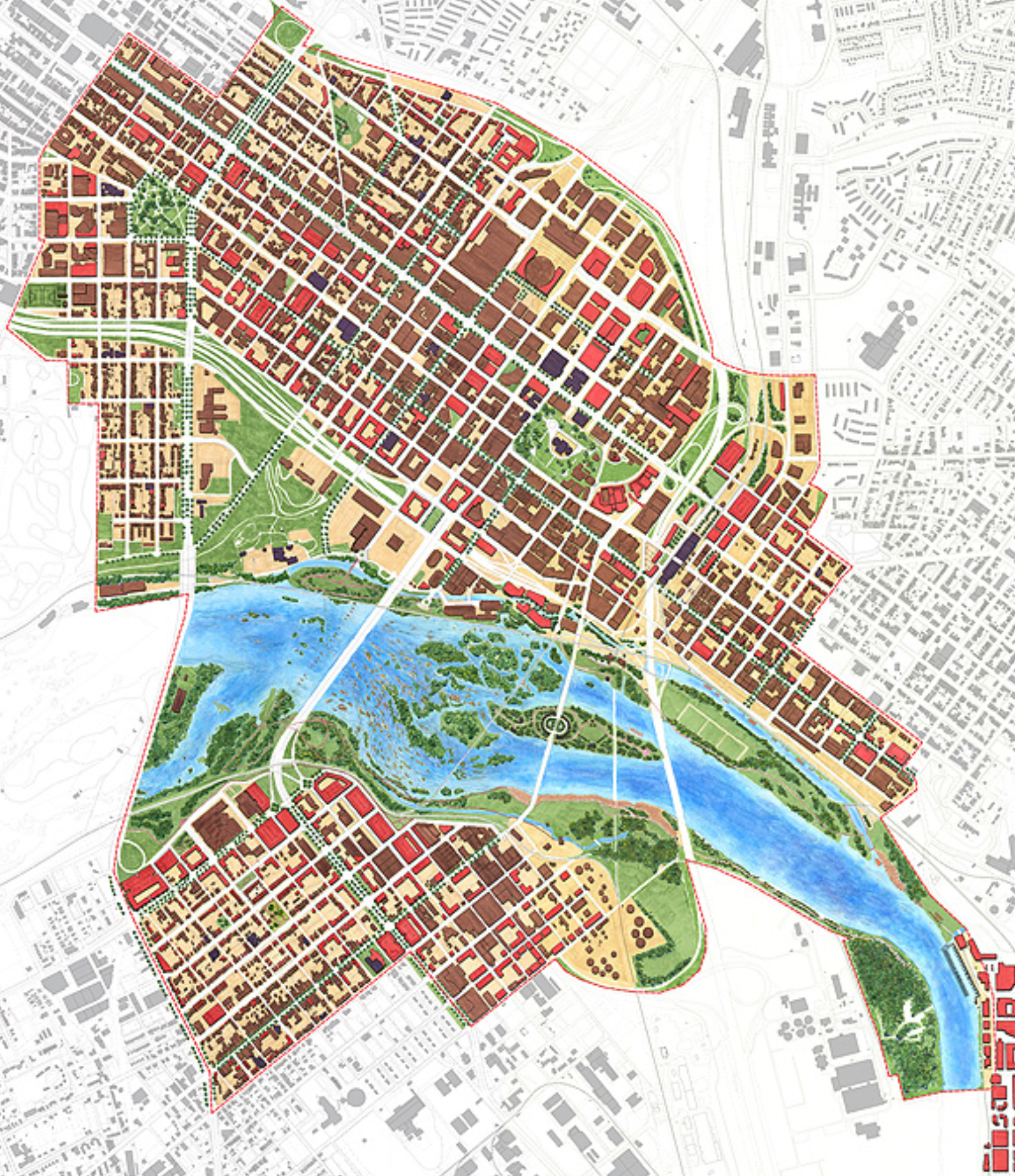The Dequindre Cut Greenway, Detroit
The design of a city begins with streets and squares and neighborhoods, but it also depends on its parks and open spaces, and the connections between them. Parks, greenways and blueways give form to the neighborhoods and bring nature into the city.
The Olmsted Vaux & Co. plan for Prospect Park, Brooklyn (1868)
Genesis of the modern planning profession
Kim Williams Trail, Downtown Missoula, MT
In many ways today’s practice of city planning was born with parks. Progressive reformers, concerned with public health in the smoky industrial cities, turned to landscape architects to create ample, green, open-to-the-sky spaces where people could relax amid nature, and the air and water could be cleansed. Frederick Law Olmsted’s idea for the Emerald Necklace of interconnected parks and green corridors in Boston was a public health idea, and a water-cleanup idea, not just a leisure idea. And the first American to identify himself as a professional city planner, John Nolen, was in fact a landscape architect by training, with a long career in parks planning already behind him as he began devising new towns and reshaping old ones.
These innovators realized the planning of neighborhoods and transportation corridors and the establishment of open spaces weren’t separate acts, to be dealt with in their own separate professional silos. And they understood that the green parts of a city aren’t just leftovers, to be ignored in between the built-up areas that receive all sorts of attention from architects, engineers and real estate developers. Instead, the natural and green parts should be subjects of design in themselves, allowing for restoration and maximizing community benefits and ecological values.
Starting a plan with the public spaces
Concept for a playground and neighborhood plaza from Plan El Paso (DK&P, 2012)
When we design a neighborhood, we begin with the green parts. We start with the tree-lined streets that link the small spaces where neighbors of all ages come together—including the youngest and oldest among us—and then work our way out to the playfields where children learn teamwork and grow fit, to the greenbelt or natural edges that shape the neighborhood, then to the trails or greenways that give respite in our busy daily lives.
Dover, Kohl & Partners’ original vision for Museum Park in Miami, 2001 (Illustration: Pedro-Pablo Godoy)
Starting with the public space makes life the focus of placemaking, and makes real estate development the backdrop. This is the right order of things, because public spaces are where our memories of cities are formed.
Silos
DK&P concept for transit-oriented development & public square along the South Dade Transitway (2018)
Dover, Kohl & Partners concept for a park in the heart of North Beach (2016)
Today’s parks and recreation programs are often operated in their own departments, separated from the day to day work of city planning departments, but their plans should be integrated, especially now, when park spaces hold the lifesaving, economy-saving solutions for urbanism in the era of climate change.
Pennypack Park, Philadelphia (Photo: Sandy Sorlien)
Rock Creek Park, Washington DC (Photo: Orhan)
Bryant Park, in Manhattan (Photo: James Dougherty)
The economic power of parks
Parks do cost money in a city’s budget, but they add value straight back to the city’s revenue base and to the wealth of surrounding property owners. They save taxpayers money, too:
In the seminal study of its kind, Pennypack Park in Philadelphia was shown to have a positive impact on the value of surrounding taxable real estate of $2,600 per household. That’s $3.36 million per year—in 1974 dollars. (That’s about $17.5 million in 2020.)
Each year, Washington’s Rock Creek Park results in nearly $9 million in additional property taxes to cover crucial municipal needs in the District of Columbia.
Bryant Park in Manhattan offers a story of return on investment. Thanks to its renovation in the early 1990s, with its famous movable tables and chairs, Bryant Park now draws visits from 20,000 people each day. Rents in surrounding areas rose 56% between 1990 and 2002; in the same period, rents on properties directly overlooking the park rose an astonishing 170%.
Physical activities in Sacramento parks yield an estimated $20 million per year in medical-cost savings alone.
Getting there
A basic national goal has been set of having park space within ten minutes’ walk of every home. It’s a start. But it’s not just a matter of keeping the distance short—we also need good means of getting there. Nonmotorized transportation on bike-friendly, walk-friendly streets and multi-user trails are needed to connect our local parks to where we live and work and go to school. Once you arrive, a park should greet citizens with openness and a sense of welcome. In New York City, the Parks Department has spent the last several years removing the barricades and tall metal fences that once walled off the parks from the neighborhoods that surround them. Today we can see what NYC Parks Commissioner Mitchell Silver calls “parks without borders,” extending through these renewed connections to give everyone the option of a park life.
Even at the super-regional scale
Large-scale trail systems, like the East Coast Greenway, are gradually taking the interconnected web of park life to the next level, allowing for long nonmotorized commutes and bike tourism. The visions for these systems extend beyond the borders of municipalities and states, linking vast regions. It’s not a new idea. The proving ground for this super-regional approach was the beloved Appalachian Trail, first proposed by naturalist Benton MacKaye in 1921. MacKaye and his followers believed the key to human mental health and happiness was regular exposure to three “elemental landscapes,” essentially consisting of wilderness, working landscapes (like farms and working waterfronts), and cities. MacKaye saw park systems as offering a chance to offset the dehumanizing, de-naturalizing effects of mechanistic industrial work and brutal commerce—which he called “de-creation”—with what has since commonly come to be known as recreation:
“We need the big sweep of hills or sea as tonic for our jaded nerves - And so Mr. Benton MacKaye offers us a new theme in regional planning. It is not a plan for more efficient labor, but a plan of escape. He would as far as is practicable conserve the whole stretch of the Appalachian Mountains for recreation. Recreation in the biggest sense - the recreation of the spirit that is being crushed by the machinery of the modem industrial city - the spirit of fellowship and cooperation.”
Clarence Stein, 1921
Parco delle Rimembranze, Venice.
Green spaces and our physical and mental well-being
We know now that Olmsted, Nolen, Stein and MacKaye—among many others—were onto something big. Decades of scientific studies have linked regular access to green space for physical activity to chronic disease prevention, and the data show that just seeing green spaces speeds healing and boosts wellness. The NRPA Report from 2010 found that a thirty-minute walk among trees “lowers blood glucose levels far more than the same amount of time spent doing physical activity in other settings. Half-hour walks in forest result in larger drops in blood glucose than three hours of cycling.” The same report documents how twenty minutes of walking in a park improved concentration among kids with ADHD at least as much as two frequently prescribed ADHD drugs! Eight separate large-scale clinical studies found that regular visits to green spaces dramatically reduce stress (Stigsdotter, 2010 and Maller, 2008). Dutch researchers established that diagnoses of anxiety disorders are 44 percent higher in residential areas with less green space than in communities well-supplied with parks.
Listening to the land
The traditions in landscape architecture show us that parks, greenways and waterways take their best form when designers listen closely to the lay of the land, from the way the topography rolls, and folding in the natural courses of stormwater. Designed this way, the green weave supports not just human happiness but flood control, water quality, flyways for birds, pollinator corridors for winged insects, the food web, and adaptation to climate change and sea level rise.
The continuum of green: Newfield & its environs (Dover, Kohl & Partners, 2019)
Continuum of green
Pulling all this together, modern day parks-planning practitioners like David Barth describe a “continuum of green” that extends from the tiniest tot lot or pocket park, to the community garden, to the neighborhood square, to the recreational fields, to large scale parks, to restoration of wilderness and conservation areas, and beyond, all interconnected by greenways, tree-lined streets, broad green boulevards, and trails.
Parks, greenways, & blueways are spotlighted in Episode 12 of Town Planning Stuff Everyone Needs to Know. They are of primary importance and they affect everything. As Miami-Dade County’s parks director Maria Nardi likes to say, “Parks just might save the world.”
For more information, check out the Ten Minute Walk commitment campaign from the National Recreation and Parks Association, the Trust for Public Land and others. Also, go to NRPA’s website to learn how to become a Parks Champion.
Parks without borders: Neighborhood square conceived by DK&P for Raleigh (2008)




